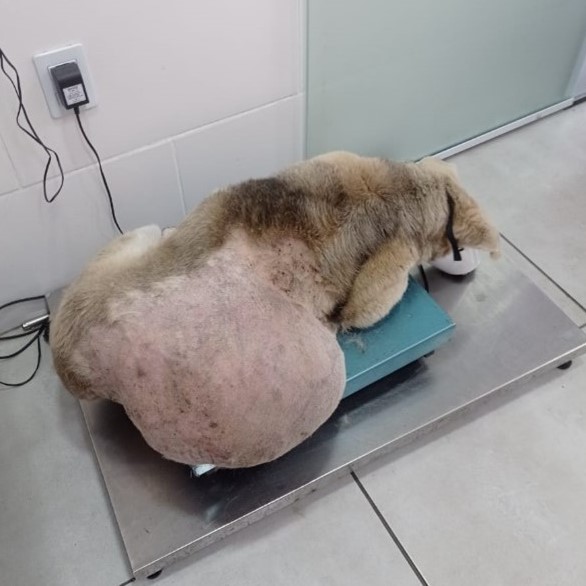Importance of histopathological analysis in the diagnosis of soft tissue sarcoma
Case report
DOI:
https://doi.org/10.31533/pubvet.v18n11e1678Keywords:
canine, diagnosis, histopathology, neoplasia, oncologyAbstract
The present work aimed to inform on the importance of diagnosis through histopathological analysis of a grade II soft tissue sarcoma in a mixed breed female dog. Soft tissue sarcoma (STS) is a type of malignant neoplasm that originates from mesenchymal tissues, affecting several species, but is more prevalent in medium-sized and elderly dogs. Clinical signs are variable and depend on the location of the tumor, generally occurring in the pelvic limbs. In the present report, the patient in question had a history of a subcutaneous mass measuring 30 cm in diameter, weighing 5 kg, located on the right flank and pelvic limb. Therefore, the diagnosis was initiated through laboratory and cytopathological tests; however, definitive confirmation was obtained through histopathological analysis, confirming the diagnosis. Therefore, histopathological diagnosis is extremely important in determining the prognosis and choosing the most effective treatment, with surgical resection being the most indicated treatment for these cases. Although the prognosis is generally favorable after complete removal of the neoplastic mass, factors such as size, location and grade of the tumor significantly influence clinical results, as in the case discussed, thus reinforcing the need for a multidisciplinary approach in the diagnosis and treatment of STS, in order to promote quality of life for patients.
References
Castro, P. F., Campos, A. G., & Matera, J. M. (2019). Sarcoma de tecidos moles em cães: a ressecção cirúrgica cura? Revista de Educação Continuada em Medicina Veterinária e Zootecnia do CRMV-SP, 17(2), 48–54.
Cavalcanti, E. B. O. (2019). Caracterização clínica, histopatológica e morfométrica dos sarcomas de tecidos moles em cães e impacto no prognóstico.
Cunha, J. P., Ghisleni, G., Scarampella, F., Fabbrini, F., Sforna, M., Cornegliani, L., Caniatti, M., Avallone, G., Moore, P., & Roccabianca, P. (2014). Cytologic and immunocytochemical characterization of feline progressive histiocytosis. Veterinary Cinical Pathologylinical, 43(3), 428–436. https://doi.org/10.1111/vcp.12152.
Demetriou, J. L., Brearley, M. J., Constantino-Casas, F., Addington, C., & Dobson, J. (2012). Intentional marginal excision of canine limb soft tissue sarcomas followed by radiotherapy. Journal of Small Animal Practice, 53(3), 174–181. https://doi.org/10.1111/j.1748-5827.2011.01186.x.
Dennis, M. M., McSporran, K. D., Bacon, N. J., Schulman, F. Y., Foster, R. A., & Powers E., B. (2011). Fatores prognósticos para sarcomas cutâneos e subcutâneos de tecido mole em cães. Patologia Veterinária, 48(1), 73–84.
Dernell, W. S., Withrow, S. J., Kuntz, C. A., & Powers, B. E. (1998). Principles of treatment for soft tissue sarcoma. Clinical Techniques in Small Animal Practice, 13(1), 59–64. https://doi.org/10.1016/S1096-2867(98)80029-7.
Ehrhart, N. (2005). Soft-tissue sarcomas in dogs: a review. Journal of the American Animal Hospital Association, 41(4), 241–246. https://doi.org/10.5326/0410241.
Ghisleni, G., Roccabianca, P., Ceruti, R., Stefanello, D., Bertazzolo, W., Bonfanti, U., & Caniatti, M. (2006). Correlation between fine-needle aspiration cytology and histopathology in the evaluation of cutaneous and subcutaneous masses from dogs and cats. Veterinary Clinical Pathology, 35(1). https://doi.org/10.1111/j.1939-165X.2006.tb00084.x.
Kuntz, C. A., Dernell, W. S., Powers, B. E., Devitt, C., Straw, R. C., & Withrow, S. J. (1997). Prognostic factors for surgical treatment of soft-tissue sarcomas in dogs: 75 cases (1986-1996). Journal of the American Veterinary Medical Association, 211(9), 1956–1966. https://doi.org/10.2460/javma.1997.211.09.1147.
Machado, G. G. (2023). Tratamento do sarcoma de tecidos moles em cães: uma revisão de literatura. Universidade Estadual Paulista (Unesp).
McAporram, M. C. (2009). O grau histológico prevê recorrência de sarcomas subcutâneos de tecidos moles caninos excisados marginalmente. Patologia Veterinária, 46(5), 928–933. https://doi.org/10.1354/VP.08-0277-M-FL.
Silveira, M. F., Gamba, C. O., Guim, T. N., Bonel-Raposo, J., & Fernandes, C. G. (2012). Características epidemiológicas de sarcomas de tecidos moles caninos e felinos: levantamento de 30 anos. Revista Acadêmica Ciência Animal, 10(4), 361–365. https://doi.org/10.7213/academica.7742.
Teixeira, L. E. M., Araújo, I. D., Miranda, R. H., Magalhães, G. A., Ghedini, D. F., & Andrade, M. A. P. (2008). Influência da manipulação prévia no tratamento e na recidiva local dos sarcomas de tecidos moles. Acta Ortopédica Brasileira, 16, 201–206.
Trojani, M., Contesso, G., Coindre, J. M., Rouesse, J., Bui, N. B., De Mascarel, A., Goussot, J. F., David, M., Bonichon, F., & Lagarde, C. (1984). Soft‐tissue sarcomas of adults; study of pathological prognostic variables and definition of a histopathological grading system. International Journal of Cancer, 33(1), 37–42. https://doi.org/10.1002/ijc.2910330108.
Vail, D. M., Thamm, D. H., & Liptak, J. M. (2019). Withrow and MacEwen’s Small Animal Clinical Oncology-E-Book. Elsevier Health Sciences.
Withrow, S. J., Page, R., & Vail, D. M. (2020). Small animal clinical oncology. Elsevier Health Sciences. https://doi.org/10.1201/9781315381855.
Zachary, J. F., McGavin, D., & McGavin, M. D. (2012). Bases da patologia em veterinária. Elsevier Brasil.

Downloads
Published
Issue
Section
License
Copyright (c) 2024 Aline Andrade de Oliveira, Max Wilson Pinto Gomes, Daniela de Carvalho Martins

This work is licensed under a Creative Commons Attribution 4.0 International License.
Você tem o direito de:
Compartilhar — copiar e redistribuir o material em qualquer suporte ou formato
Adaptar — remixar, transformar, e criar a partir do material para qualquer fim, mesmo que comercial.
O licenciante não pode revogar estes direitos desde que você respeite os termos da licença. De acordo com os termos seguintes:
Atribuição
— Você deve dar o crédito apropriado, prover um link para a licença e indicar se mudanças foram feitas. Você deve fazê-lo em qualquer circunstância razoável, mas de nenhuma maneira que sugira que o licenciante apoia você ou o seu uso. Sem restrições adicionais
— Você não pode aplicar termos jurídicos ou medidas de caráter tecnológico que restrinjam legalmente outros de fazerem algo que a licença permita.




